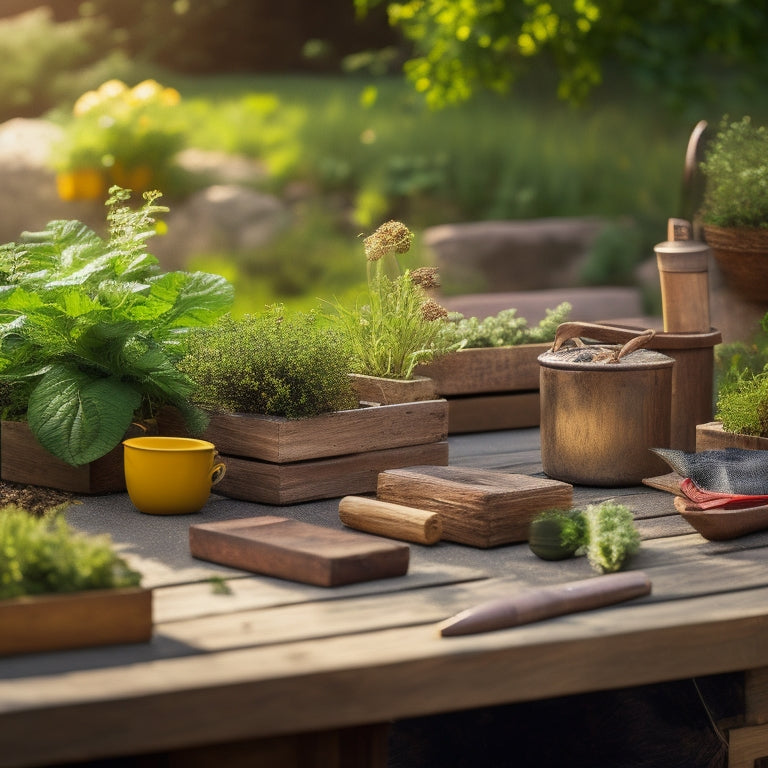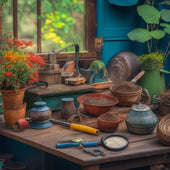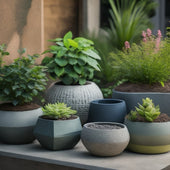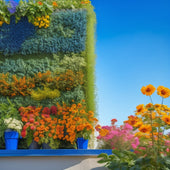
Why Bother With DIY Block Planters on Budget
Share
You can transform your outdoor space without overspending by creating a DIY block planter on a budget. By sourcing affordable cinder blocks locally or online, and upcycling old blocks to perfection, you'll save money and add a personal touch. With a little creativity, you can design a unique planter that reflects your style, from vertical systems to decorative finishes. Essential tools like a trowel, level, and rubber mallet will help you get the job done efficiently. By leveraging time-saving hacks, you'll be enjoying your new planter in no time. And, with a few more clever tricks up your sleeve, you'll be amazed at what you can achieve.
Key Takeaways
• DIY block planters on a budget offer a cost-effective way to create unique and personalized garden features.
• Upcycling old blocks reduces waste, conserves resources, and promotes sustainability.
• With creative design ideas, DIY block planters can add visual appeal and functionality to outdoor spaces.
• Essential tools and time-saving renovation hacks enable efficient project completion, even for beginners.
• Repurposed blocks can be sourced for free or at a low cost, making DIY planters an accessible and budget-friendly option.
Budget-Friendly Cinder Block Sources
Where can you find affordable cinder blocks to build your planters without breaking the bank? You're in luck because there are several budget-friendly options to explore.
First, check out local hardware stores in your area. They often carry cinder blocks at competitive prices, and you might even find discounts or promotions.
Additionally, you can visit community sales or online marketplaces where individuals sell used or excess cinder blocks at a lower cost. You can also post an ad on social media or local online classifieds to find people giving away free cinder blocks.
Another option is to scour construction sites or renovation projects in your neighborhood, where you might be able to score free or low-cost cinder blocks. Just be sure to ask permission before taking any materials.
Upcycling Old Blocks to Perfection
With a few simple steps and some TLC, you can transform those rough, worn-out cinder blocks into stunning planters that add a touch of industrial chic to your garden or patio. Upcycling old blocks is not only eco-friendly, but it's also a great way to give your garden a unique, sustainable gardening vibe.
Here's a step-by-step guide to upcycle your old blocks:
| Step | Task | Materials Needed |
|---|---|---|
| 1 | Clean the blocks | Wire brush, soap, and water |
| 2 | Sand the blocks | Sandpaper |
| 3 | Paint the blocks (optional) | Paint, primer (optional) |
| 4 | Add a layer of sealant | Sealant, paintbrush |
| 5 | Assemble the planter | Blocks, soil, plants |
Creative Planter Design Ideas
How can you get creative with your DIY block planters to make them truly stand out in your outdoor space?
You can start by experimenting with unique shapes and layouts. Consider creating a vertical gardening system by stacking blocks to form a tower, or arrange them in a geometric pattern to add visual interest.
You can also add decorative finishes to give your planters a personalized touch. Try applying a coat of paint or stain to match your outdoor decor, or add a mosaic tile design for a pop of color.
Another idea is to incorporate additional design elements, such as built-in irrigation systems or trellises for climbing plants.
You can also add a personal message or decorative symbol using stencils or carvings.
Get creative with the type of plants you choose as well – mix and match different textures, colors, and sizes to create a visually appealing display.
Essential Tools for the Job
You'll need to gather the right tools to bring your creative block planter design to life.
Don't worry, you won't need a plethora of fancy gadgets, but having the essentials will make the process smoother and more enjoyable.
For tool selection, focus on the basics: a sturdy trowel for mixing and applying mortar, a level to guarantee your blocks are straight, and a rubber mallet for tapping them into place. A measuring tape, pencil, and safety glasses will also come in handy.
When it comes to maintenance tips, remember to clean your tools after each use to prevent rust and keep them in good condition.
Regularly sharpen your trowel to maintain its effectiveness. Additionally, store your tools in a dry, protected area to prolong their lifespan.
Time-Saving Renovation Hacks
Tackling a DIY block planter project can be overwhelming, but incorporating a few clever renovation hacks into your workflow can save you hours of frustration and labor. By prioritizing time management and renovation efficiency, you'll be able to complete your project quickly and effortlessly. Here are some hacks to get you started:
| Hack | Time Saved | Efficiency Boost |
|---|---|---|
| Prepare all materials in advance | 30 minutes | 20% |
| Use a level to guarantee straight lines | 20 minutes | 15% |
| Work in sections to avoid mess | 45 minutes | 25% |
| Measure twice, cut once to avoid errors | 1 hour | 30% |
Frequently Asked Questions
Can I Use DIY Block Planters for Indoor Gardening Projects?
You can definitely use DIY block planters for indoor gardening projects! In fact, they're a great option for adding some greenery to your space.
Since block planters are versatile, you can customize them to fit your indoor gardening needs. Plus, they're easy to move around, making it simple to adjust the layout of your plants as needed.
Just make sure you choose a planter that fits your plant's size and has proper drainage.
Do I Need to Seal Cinder Blocks to Protect Them From Weather?
Imagine your DIY block planter standing strong like the ancient Roman Colosseum, defying the elements.
But, unlike the Colosseum, your cinder blocks need protection from weathering. You'll need to seal them to prevent water seepage and erosion.
For cinder block maintenance, apply a waterproofing sealant to protect them from harsh weather conditions.
Explore weatherproofing techniques like silicone coatings or acrylic paints to guarantee your planter remains sturdy and your plants thrive.
How Long Do DIY Cinder Block Planters Typically Last Outdoors?
You're wondering how long your DIY cinder block planters will last outdoors.
Well, their durability depends on the outdoor conditions they're exposed to. If you seal them properly, they can last for 5-7 years, but if you don't, they might only make it 2-3 years.
Harsh weather, like heavy rainfall or extreme temperatures, will reduce their lifespan.
With proper care and maintenance, you can extend their life, but it's crucial to monitor their condition regularly.
Are DIY Block Planters Suitable for Growing Vegetables and Herbs?
Imagine growing a jungle of juicy tomatoes, crunchy carrots, and fragrant basil in your DIY block planters!
You can, because they're absolutely suitable for growing a wide range of vegetable varieties and herb selection.
From leafy greens like kale and spinach to root veggies like beets and radishes, and even delicate herbs like parsley and dill, your block planters can support them all.
Just make sure to choose a well-draining potting mix and provide the right amount of sunlight and water for your chosen crops.
Can I Move DIY Cinder Block Planters After They're Built and Planted?
When you're wondering if you can move your DIY cinder block planters after they're built and planted, the answer is yes, but with caution.
Make certain the planter stability isn't compromised, as heavy soil and plants can shift during transport.
You'll want to lift carefully to avoid damaging the blocks or dislodging the soil.
Moving planters can be done, but plan ahead, and consider enlisting help to guarantee a smooth changeover.
Conclusion
You've made it to the end of this DIY block planter journey, and the question remains: why bother?
The truth is, DIY block planters on a budget aren't just a creative outlet, but a sustainable way to reduce waste and reuse materials.
According to the EPA, upcycling helps reduce greenhouse gas emissions by 117 million metric tons annually.
So, by choosing to repurpose cinder blocks, you're not only saving money, but also doing your part for the environment.
Related Posts
-

5 Must-Knows for Buying Used Tools for Planters
When buying used tools for planters, you're investing in the reliability and performance of your operations, so it's ...
-

5 Must-Knows for Buying Used Tools for Planters
When buying used tools for planters, you're investing in the reliability and performance of your operations, so it's ...
-

5 Must-Knows for Buying Used Tools for Planters
When buying used tools for planters, you're investing in the reliability and performance of your operations, so it's ...
-

5 Must-Knows for Buying Used Tools for Planters
When buying used tools for planters, you're investing in the reliability and performance of your operations, so it's ...
-

5 Must-Knows for Buying Used Tools for Planters
When buying used tools for planters, you're investing in the reliability and performance of your operations, so it's ...
-

5 Must-Knows for Buying Used Tools for Planters
When buying used tools for planters, you're investing in the reliability and performance of your operations, so it's ...
-

5 Must-Knows for Buying Used Tools for Planters
When buying used tools for planters, you're investing in the reliability and performance of your operations, so it's ...
-

5 Must-Knows for Buying Used Tools for Planters
When buying used tools for planters, you're investing in the reliability and performance of your operations, so it's ...
-

5 Must-Knows for Buying Used Tools for Planters
When buying used tools for planters, you're investing in the reliability and performance of your operations, so it's ...
-

5 Must-Knows for Buying Used Tools for Planters
When buying used tools for planters, you're investing in the reliability and performance of your operations, so it's ...
-

5 Must-Knows for Buying Used Tools for Planters
When buying used tools for planters, you're investing in the reliability and performance of your operations, so it's ...
-

5 Must-Knows for Buying Used Tools for Planters
When buying used tools for planters, you're investing in the reliability and performance of your operations, so it's ...
-

5 Must-Knows for Buying Used Tools for Planters
When buying used tools for planters, you're investing in the reliability and performance of your operations, so it's ...
-

5 Must-Knows for Buying Used Tools for Planters
When buying used tools for planters, you're investing in the reliability and performance of your operations, so it's ...
-

5 Must-Knows for Buying Used Tools for Planters
When buying used tools for planters, you're investing in the reliability and performance of your operations, so it's ...
-

5 Must-Knows for Buying Used Tools for Planters
When buying used tools for planters, you're investing in the reliability and performance of your operations, so it's ...
-

5 Must-Knows for Buying Used Tools for Planters
When buying used tools for planters, you're investing in the reliability and performance of your operations, so it's ...
-

5 Must-Knows for Buying Used Tools for Planters
When buying used tools for planters, you're investing in the reliability and performance of your operations, so it's ...
-

5 Must-Knows for Buying Used Tools for Planters
When buying used tools for planters, you're investing in the reliability and performance of your operations, so it's ...
-

5 Must-Knows for Buying Used Tools for Planters
When buying used tools for planters, you're investing in the reliability and performance of your operations, so it's ...
-

5 Best DIY Planter Ideas to Upcycle Concrete
You're about to breathe new life into discarded concrete blocks by transforming them into functional and visually app...
-

5 Best DIY Planter Ideas to Upcycle Concrete
You're about to breathe new life into discarded concrete blocks by transforming them into functional and visually app...
-

5 Best DIY Planter Ideas to Upcycle Concrete
You're about to breathe new life into discarded concrete blocks by transforming them into functional and visually app...
-

5 Best DIY Planter Ideas to Upcycle Concrete
You're about to breathe new life into discarded concrete blocks by transforming them into functional and visually app...
-

5 Best DIY Planter Ideas to Upcycle Concrete
You're about to breathe new life into discarded concrete blocks by transforming them into functional and visually app...
-

5 Best DIY Planter Ideas to Upcycle Concrete
You're about to breathe new life into discarded concrete blocks by transforming them into functional and visually app...
-

5 Best DIY Planter Ideas to Upcycle Concrete
You're about to breathe new life into discarded concrete blocks by transforming them into functional and visually app...
-

5 Best DIY Planter Ideas to Upcycle Concrete
You're about to breathe new life into discarded concrete blocks by transforming them into functional and visually app...
-

5 Best DIY Planter Ideas to Upcycle Concrete
You're about to breathe new life into discarded concrete blocks by transforming them into functional and visually app...
-

5 Best DIY Planter Ideas to Upcycle Concrete
You're about to breathe new life into discarded concrete blocks by transforming them into functional and visually app...
-

5 Best DIY Planter Ideas to Upcycle Concrete
You're about to breathe new life into discarded concrete blocks by transforming them into functional and visually app...
-

5 Best DIY Planter Ideas to Upcycle Concrete
You're about to breathe new life into discarded concrete blocks by transforming them into functional and visually app...
-

5 Best DIY Planter Ideas to Upcycle Concrete
You're about to breathe new life into discarded concrete blocks by transforming them into functional and visually app...
-

5 Best DIY Planter Ideas to Upcycle Concrete
You're about to breathe new life into discarded concrete blocks by transforming them into functional and visually app...
-

5 Best DIY Planter Ideas to Upcycle Concrete
You're about to breathe new life into discarded concrete blocks by transforming them into functional and visually app...
-

5 Best DIY Planter Ideas to Upcycle Concrete
You're about to breathe new life into discarded concrete blocks by transforming them into functional and visually app...
-

5 Best DIY Planter Ideas to Upcycle Concrete
You're about to breathe new life into discarded concrete blocks by transforming them into functional and visually app...
-

5 Best DIY Planter Ideas to Upcycle Concrete
You're about to breathe new life into discarded concrete blocks by transforming them into functional and visually app...
-

5 Tips for Thriving Vertical Vegetable Gardens
To thrive in vertical vegetable gardening, you'll want to choose a planter that meets the unique needs of your veggie...
-

5 Tips for Thriving Vertical Vegetable Gardens
To thrive in vertical vegetable gardening, you'll want to choose a planter that meets the unique needs of your veggie...
-

5 Tips for Thriving Vertical Vegetable Gardens
To thrive in vertical vegetable gardening, you'll want to choose a planter that meets the unique needs of your veggie...
-

5 Tips for Thriving Vertical Vegetable Gardens
To thrive in vertical vegetable gardening, you'll want to choose a planter that meets the unique needs of your veggie...
-

5 Tips for Thriving Vertical Vegetable Gardens
To thrive in vertical vegetable gardening, you'll want to choose a planter that meets the unique needs of your veggie...
-

5 Tips for Thriving Vertical Vegetable Gardens
To thrive in vertical vegetable gardening, you'll want to choose a planter that meets the unique needs of your veggie...
-

5 Tips for Thriving Vertical Vegetable Gardens
To thrive in vertical vegetable gardening, you'll want to choose a planter that meets the unique needs of your veggie...
-

5 Tips for Thriving Vertical Vegetable Gardens
To thrive in vertical vegetable gardening, you'll want to choose a planter that meets the unique needs of your veggie...
-

5 Tips for Thriving Vertical Vegetable Gardens
To thrive in vertical vegetable gardening, you'll want to choose a planter that meets the unique needs of your veggie...
-

5 Tips for Thriving Vertical Vegetable Gardens
To thrive in vertical vegetable gardening, you'll want to choose a planter that meets the unique needs of your veggie...
-

5 Tips for Thriving Vertical Vegetable Gardens
To thrive in vertical vegetable gardening, you'll want to choose a planter that meets the unique needs of your veggie...
-

5 Tips for Thriving Vertical Vegetable Gardens
To thrive in vertical vegetable gardening, you'll want to choose a planter that meets the unique needs of your veggie...
-

5 Tips for Thriving Vertical Vegetable Gardens
To thrive in vertical vegetable gardening, you'll want to choose a planter that meets the unique needs of your veggie...
-

5 Tips for Thriving Vertical Vegetable Gardens
To thrive in vertical vegetable gardening, you'll want to choose a planter that meets the unique needs of your veggie...
-

5 Tips for Thriving Vertical Vegetable Gardens
To thrive in vertical vegetable gardening, you'll want to choose a planter that meets the unique needs of your veggie...
-

5 Tips for Thriving Vertical Vegetable Gardens
To thrive in vertical vegetable gardening, you'll want to choose a planter that meets the unique needs of your veggie...
-

5 Tips for Thriving Vertical Vegetable Gardens
To thrive in vertical vegetable gardening, you'll want to choose a planter that meets the unique needs of your veggie...


